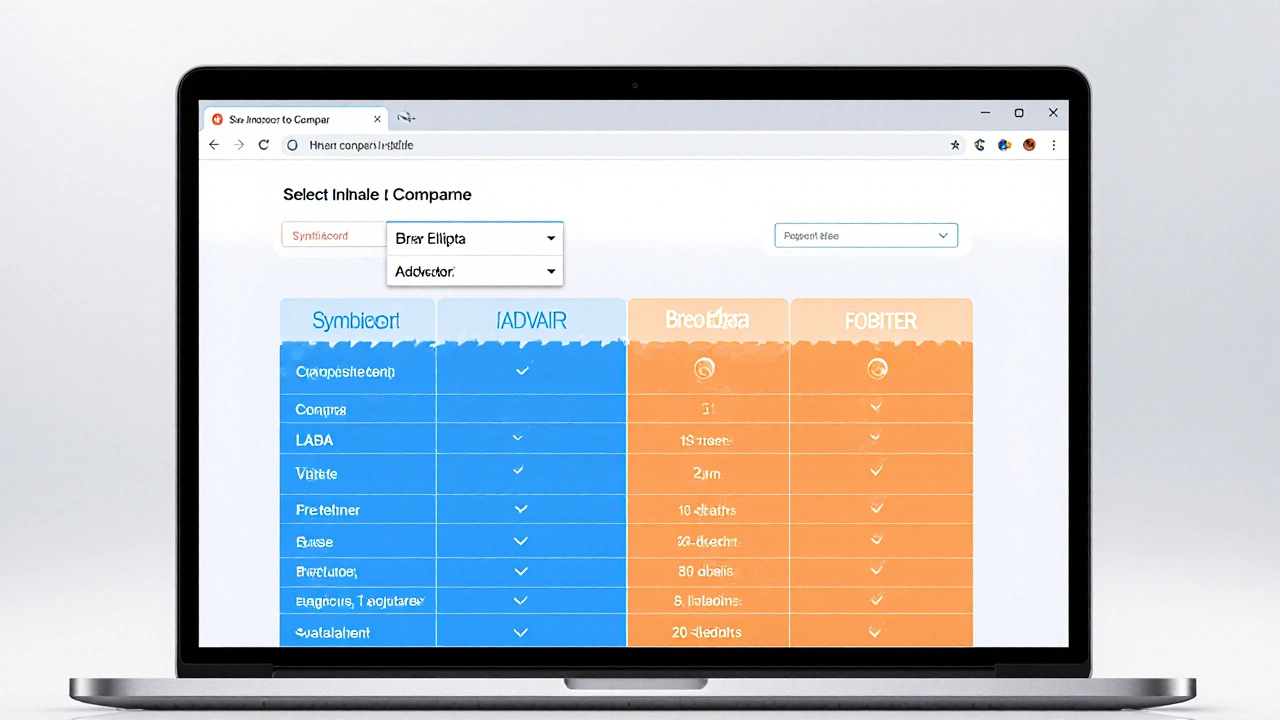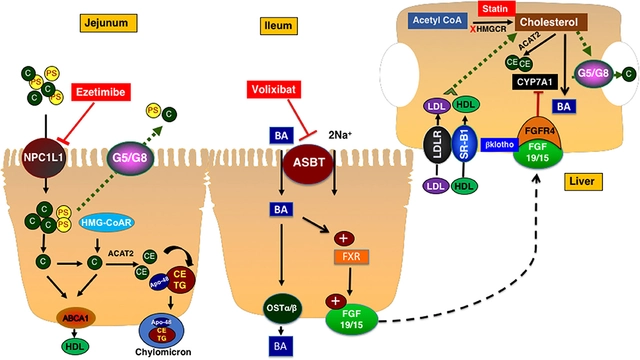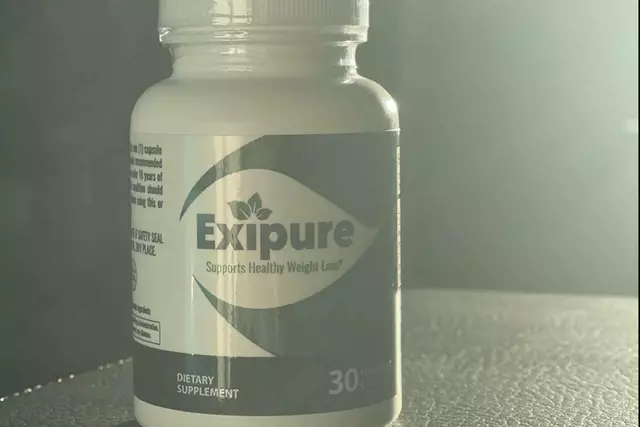Symbicort vs. Inhaler Alternatives Comparison Tool
| Attribute | Selected Inhaler | Compared Against |
|---|---|---|
| Corticosteroid | ||
| LABA Component | ||
| Typical Dose (Asthma) | ||
| Frequency | ||
| Device Type | ||
| Availability (Australia) |
| Adverse Event | Selected Inhaler | Compared Against |
|---|---|---|
| Oral Thrush | ||
| Hoarseness | ||
| Systemic Cortisol Suppression |
Quick Facts
- Symbicort combines Budesonide (corticosteroid) and Formoterol (LABA) in a single metered‑dose inhaler.
- Typical dose for asthma: 80/4.5µg twice daily; for COPD: 160/4.5µg twice daily.
- Major alternatives include Advair, Breo Ellipta, Dulera, and Fostair.
- All combos target two pathways: inflammation (corticosteroid) and bronchodilation (long‑acting β2‑agonist).
- Choosing the right inhaler depends on dosing convenience, cost, device preference, and side‑effect profile.
How Symbicort Works
When treating asthma or COPD, Symbicort is a combination inhaler containing budesonide (a potent inhaled corticosteroid) and formoterol (a rapid‑onset long‑acting β2‑agonist). Budesonide binds to glucocorticoid receptors in airway cells, suppressing the release of cytokines and reducing edema. Formoterol activates β2 receptors, relaxing smooth muscle within minutes and maintaining airway patency for up to 12hours.
A 2023 meta‑analysis of 12 randomized trials showed that Symbicort reduced severe asthma exacerbations by 30% compared with placebo and improved FEV₁ by an average of 0.15L after 12weeks of therapy.
Top Inhaler Alternatives
Several other fixed‑dose combos compete in the same therapeutic space. Below is a snapshot of each.
- Advair pairs fluticasone propionate (corticosteroid) with salmeterol (LABA). It’s available in both Diskus powder and metered‑dose formats. Doses range from 100/50µg to 500/50µg, taken twice daily.
- Breo Ellipta delivers fluticasone furoate and vilanterol once daily via a breath‑actuated dry‑powder inhaler. The once‑daily schedule appeals to patients who struggle with twice‑daily regimens.
- Dulera contains mometasone furoate and formoterol, similar to Symbicort but with a different corticosteroid. It’s marketed mainly for children aged6years and older.
- Fostair mixes beclometasone dipropionate with formoterol. It is popular in the UK and Australia for both asthma and COPD, offering doses from 100/6µg to 200/6µg, twice daily.

Side‑Effect Profile Across Products
All inhaled corticosteroid/LABA combos share a core safety profile, but subtle differences exist.
| Adverse Event | Symbicort | Advair | Breo Ellipta | Dulera | Fostair |
|---|---|---|---|---|---|
| Oral thrush | 4% | 5% | 3% | 5% | 4% |
| Hoarseness | 3% | 4% | 2% | 3% | 3% |
| Systemic cortisol suppression (high‑dose long term) | Rare | Rare | Very rare | Rare | Rare |
Comparison Table
| Product | Corticosteroid | LABA | Typical Dose (asthma) | Frequency | Device Type | Availability (Australia) |
|---|---|---|---|---|---|---|
| Symbicort | Budesonide | Formoterol | 80/4.5µg | Twice daily | Metered‑dose inhaler (MDI) | Available |
| Advair | Fluticasone propionate | Salmeterol | 100/50µg | Twice daily | Diskus powder or MDI | Available |
| Breo Ellipta | Fluticasone furoate | Vilanterol | 100/25µg | Once daily | Dry‑powder inhaler | Available |
| Dulera | Mometasone furoate | Formoterol | 100/5µg | Twice daily | MDI | Limited (pediatric) |
| Fostair | Beclometasone dipropionate | Formoterol | 100/6µg | Twice daily | MDI | Available |
Choosing the Right Inhaler for You
Below is a quick decision guide. Ask yourself:
- Do I need a once‑daily regimen? If yes, Breo Ellipta’s 24‑hour coverage is a strong contender.
- Is cost a major factor? In the Australian PBS schedule, Symbicort and Advair are similarly subsidised, while Breo may carry a higher out‑of‑pocket cost.
- Do I prefer a metered‑dose inhaler over a dry‑powder device? Some patients find the tactile click of an MDI reassuring; others struggle with the inspiratory flow required for DPIs.
- Am I treating a child? Dulera is the only product in this list approved for children as young as six.
Ultimately, the best inhaler aligns with your lifestyle, the severity of your disease, and any comorbidities such as cardiovascular risk (LABA can cause tachycardia in sensitive individuals).
Practical Tips for Maximising Benefit
- Always rinse your mouth after each dose to reduce the risk of thrush.
- Check the inhaler’s expiration date; propellant degradation can lower delivered dose.
- Use a spacer with MDIs if you have coordination difficulties; it improves lung deposition by up to 30%.
- Track your peak flow readings weekly; a sudden dip may signal the need for a step‑up in therapy.

Frequently Asked Questions
Can I switch from Symbicort to another inhaler without a doctor’s visit?
No. All these products contain prescription‑only ingredients. A clinician must assess your disease control, inhaler technique, and any potential drug interactions before making a change.
Is Symbicort safe for pregnant women?
Budesonide is classified as Category B by the TGA, meaning animal studies show no risk and there are limited human data. Formoterol falls under Category C. Discuss benefits vs. risks with your obstetrician.
How quickly does Formoterol start working?
Formoterol has a rapid onset of 1-3minutes, which is why Symbicort can be used as a reliever in the “SMART” regimen for certain patients.
Do dry‑powder inhalers like Breo need a specific inhalation technique?
Yes. A forceful, deep inhalation is required to disperse the powder. Patients with severe airflow limitation may struggle, making an MDI with a spacer a better option.
What is the cost difference between Symbicort and Advair in Australia?
Both are listed on the PBS; the patient contribution is roughly AUD30 per prescription. However, private scripts for Breo Ellipta can exceed AUD100 without subsidy.





Mangal DUTT Sharma
October 3, 2025 AT 10:02Hey folks 😊, I totally get how overwhelming it can feel when you’re trying to choose the right inhaler, especially with so many options on the market these days. First off, the combination of budesonide and formoterol in Symbicort is a solid choice for many patients because it offers both anti‑inflammatory action and rapid bronchodilation. 🌬️ The rapid onset of formoterol (1‑3 minutes) means you can get quick relief while still maintaining long‑term control, which is a huge benefit for those who experience unpredictable exacerbations.
When you compare it to Advair, you’ll notice that Advair uses fluticasone and salmeterol, which has a slower onset, making Symbicort a bit more versatile in a “SMART” regimen.
On the other hand, Breo Ellipta’s once‑daily dosing can be a game‑changer for adherence, but some patients struggle with the inspiratory flow needed for dry‑powder inhalers.
If cost is a major concern, the PBS subsidies in Australia make Symbicort and Advair almost equally affordable, while Breo tends to be pricier without a subsidy.
Device preference also matters – some people love the tactile click of an MDI, whereas others prefer the breath‑actuated feel of a DPI.
Don’t forget to rinse your mouth after each dose; that simple habit can cut the risk of oral thrush by a significant margin.
And if you have coordination issues, a spacer can boost lung deposition by up to 30 %, which is something many patients overlook.
From a side‑effect standpoint, the rates of oral thrush and hoarseness are pretty comparable across these inhalers, hovering around 3‑5 % for most.
Systemic cortisol suppression remains rare, especially at the standard dosing regimens we’re discussing.
For children, Dulera is the only option on this list approved for ages 6 and up, thanks to its mometasone component.
Fostair, while popular in the UK and Australia, uses beclometasone, which some clinicians feel is a bit less potent than budesonide or fluticasone.
Ultimately, the best choice aligns with your lifestyle, inhaler technique, and any comorbidities you might have – especially cardiovascular concerns, as LABAs can cause tachycardia in sensitive individuals.
If you’re still unsure, a quick chat with your pharmacist can clarify device technique and insurance coverage.
Remember, consistency is key: track your peak flow readings weekly to catch any early signs of worsening control.
Stay empowered, stay informed, and breathe easy! 😊
Gracee Taylor
October 3, 2025 AT 10:20I think it’s great that the post breaks down the pros and cons so clearly; it really helps when you’re weighing options. The once‑daily convenience of Breo Ellipta can be a lifesaver for busy folks, while the twice‑daily schedule of Symbicort offers more flexibility in dose titration. Both devices have their sweet spots, and cost considerations often tip the scale.
Leslie Woods
October 3, 2025 AT 10:43Nice summary but I wonder about the inhaler technique differences between MDI and DPI they could affect outcomes especially for older patients
Manish Singh
October 3, 2025 AT 11:00Totally feel you Gracee Its realy important to think bout technique and also your own daily routine how you can fit an inhaler in your life. Even little things like having a spacer can make a big difference especially if coordination is a challenge. Hope u find the right fit!
Dipak Pawar
October 3, 2025 AT 11:16From a pharmacological perspective, the choice between budesonide‑formoterol and fluticasone‑salmeterol hinges on nuanced receptor affinity profiles and systemic bioavailability; budesonide exhibits a higher first‑pass metabolism which might translate to a marginally lower systemic cortisol impact, albeit both agents are generally regarded as low‑risk at standard doses. Moreover, the physicochemical properties of the propellant in MDIs versus the carrier particles in DPIs can influence the aerosol size distribution, thereby affecting peripheral deposition. Clinicians should also weigh the pharmacokinetic half‑life differences-formoterol’s rapid onset is complemented by its 12‑hour duration, whereas salmeterol’s slower onset may be offset by patient preference for the slightly longer 12‑hour coverage. In practice, tailoring therapy to patient‑specific factors such as inspiratory flow capacity, adherence patterns, and comorbidities remains paramount.
Jonathan Alvarenga
October 3, 2025 AT 11:50Honestly this whole comparison feels like marketing fluff plastered over a very similar class of drugs. The differences in side‑effect percentages are negligible, and the “once‑daily” hype for Breo is just a gimmick to get you to pay more. If you ask me, the real issue is that pharmaceutical companies drive us to chase brand names instead of looking at generics that do the exact same job. The data presented here are cherry‑picked from industry‑funded studies, so take it with a grain of salt. Most patients will end up paying extra for the convenience of a dry‑powder inhaler while getting the same bronchodilation and steroid effect. Don’t be fooled by sleek packaging; the core pharmacology hasn’t changed in decades.
Jim McDermott
October 3, 2025 AT 12:06Hey Jonathan, I see where you’re comin from but gotta say the inhaler choice does matter for individual needs. Some people actually do better with the quicker onset of formoterol especially if they have unpredictable flare‑ups. Also, the cost factor can be a real barrier, so it’s not all fluff.
Naomi Ho
October 3, 2025 AT 12:40For anyone still unsure, the key clinical takeaways are: Symbicort offers rapid relief with twice‑daily dosing, Breo Ellipta provides convenient once‑daily coverage, and both have similar safety profiles. Rinse after use to prevent thrush, and consider a spacer if you have coordination challenges.
Christine Watson
October 3, 2025 AT 13:13Great summary, Naomi! 🎉 It’s helpful to see the practical tips laid out so clearly. Keep the positivity coming!
Macy Weaver
October 3, 2025 AT 13:46I appreciate the balanced view here. It’s nice to see both the clinical data and the real‑world considerations like cost and device preference side by side.
James McCracken
October 3, 2025 AT 14:03One could argue that the very act of choosing an inhaler is a microcosm of modern existentialism-do we select the tool that promises convenience, or the one that aligns with our deeper philosophical commitment to mastery over one’s breath? In any case, the debate itself reflects our yearning for autonomy in a world of prescribed pathways.
Evelyn XCII
October 3, 2025 AT 14:20Sure, James, because breathing is definitely a philosophical pursuit-right after we finish counting the exact number of inhaler clicks. 🙄
Adrian Hernandez
October 3, 2025 AT 14:53Just another day, another inhaler debate.
duncan hines
October 3, 2025 AT 15:26Wow, Adrian, that’s the most succinct observation ever-absolutely thrilling. I can’t wait for the next page‑turner of inhaler drama.
Mina Berens
October 3, 2025 AT 16:00Interesting read! 😎 I think it really helps to lay everything out like this.
Chris Meredith
October 3, 2025 AT 16:33Hey Mina, you nailed it-clearing up confusion is a win for everyone. Let’s keep the conversation rolling and empower more folks to make informed choices! 💪